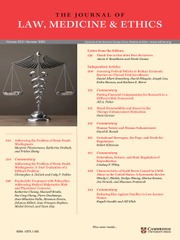No CrossRef data available.
Article contents
An Insider’s Perspective on How to Reduce Fraud in the Social Sciences
Published online by Cambridge University Press: 27 March 2025
Abstract
I will describe how a fraudulent paper developed and offer insights into the institutional changes that are needed. I was a co-author on a paper described as a “clusterfake” due to at least two frauds allegedly occurring in the same paper. I will use my knowledge of behavioral ethics and my experience as a co-author on a fraudulent paper to explore changes that are needed to improve research integrity.
Keywords
- Type
- Symposium
- Information
- Copyright
- © The Author(s), 2025. Published by Cambridge University Press on behalf of American Society of Law, Medicine & Ethics
References
Simonsohn, U. et al., “Data Falsificada (Part 1): ‘Clusterfake,’” Data Colada, June 17, 2023, https://datacolada.org/109.Google Scholar
Shu, L. et al., “Signing at the Beginning Makes Ethics Salient and Decreases Dishonest Self-Reports in Comparison to Signing at the End,” Proceedings of the National Academy of Sciences 109, no. 38 (2012): 15197–15200, https://doi.org/10.1073/pnas.1209746109.CrossRefGoogle Scholar
Schrag, M. et al., “Academic Research Integrity Investigations Must Be Independent, Fair and Timely,” Journal of Law, Medicine & Ethics 53, no. 1: xx–xx; G.A. FitzGerald, “Segregate Assessment of Biomedical Data Validity from Fraud,” Journal of Law, Medicine & Ethics 53, no. 1: xx-xx; L. Oransky and A. Marcus, “Why Universities Should Make Misconduct Reports Public,” Journal of Law, Medicine & Ethics 53, no. 1: xx-xx.Google Scholar
Simonson, U. et al., “Evidence of Fraud in an Influential Field Study about Dishonesty,” Data Colada, August 17, 2021, https://datacolada.org/98.Google Scholar
See Simonsohn, supra note 2.Google Scholar
O’Grady, K., “After Honesty Researcher’s Retractions, Colleagues Expand Scrutiny of Her Work,” Science, July 18, 2023, https://www.science.org/content/article/after-honesty-researcher-s-retractions-colleagues-expand-scrutiny-her-work.Google Scholar
Becker, G.S., “Crime and Punishment: An Economic Approach,” Journal of Political Economy 76, no. 2 (1968): 169–217, https://doi.org/10.1086/259394.CrossRefGoogle Scholar
Stapel, D., Faking Science: A Trust Story of Academic Fraud (2014), https://errorstatistics.files.wordpress.com/2014/12/fakingscience-20141214.pdf.Google Scholar
Benjamin, L.T., “History of Popular Psychology in America,” in Encyclopedia of the History of Psychological Theories, ed. Rieber, R.W. (Springer, 2012).Google Scholar
Bem, D.J., “Feeling the Future: Experimental Evidence for Anomalous Retroactive Influences on Cognition and Affect,” Journal of Personality and Social Psychology 100, no. 3 (2011): 407–25, https://doi.org/10.1037/a0021524.CrossRefGoogle ScholarPubMed
Nelson, L.D. et al., “Psychology’s Renaissance,” Annual Review of Psychology 69 (2018): 511–534, https://doi.org/10.1146/annurev-psych-122216-011836.CrossRefGoogle ScholarPubMed
Simmons, J.P. et al., “False-Positive Psychology: Undisclosed Flexibility in Data Collection and Analysis Allows Presenting Anything as Significant,” Psychological Science 22, no. 11 (2011): 1359–1366, https://doi.org/10.1177/0956797611417632.CrossRefGoogle ScholarPubMed
See Nelson, supra note 14.Google Scholar
See Nelson, supra note 14; Vazire, S., “The Next Chapter for Psychological Science,” Psychological Science 35, no. 7 (2023): 703–707, https://doi.org/10.1177/09567976231221558.Google ScholarPubMed
See Nelson, supra note 14.Google Scholar
Nosek, B.A. et al., “Standard Reviewer Statement for Disclosure of Sample, Conditions, Measures, and Exclusions,” OSFHome, https://osf.io/hadz3/.Google Scholar
See Nelson, supra note 14.Google Scholar
Hardwick, T.E. and Vazire, S., “Transparency Is Now the Default at Psychological Science,” Psychological Science 35, no. 7 (2024): 708–711, https://doi.org/10.1177/09567976231221573.CrossRefGoogle Scholar
See Hardwick, supra note 23.Google Scholar
Baer, M. and Kouchaki, M., “Reinforcing OBHDP’s Mission and Our Commitment to Helping Authors Produce Science of the Highest Quality,” Organizational Behavior and Human Decision Processes 180 (2024): 104311, https://doi.org/10.1016/j.obhdp.2024.104311.CrossRefGoogle Scholar
Briskin, J.L. and Gunsalus, C.K., “How Institutions Can Hold Themselves Accountable Through Practical Tools and Knowledge,” Journal of Law, Medicine & Ethics, this issue; I. Oransky and A. Marcus, “Why Universities Should Make Misconduct Reports Public,” Journal of Law, Medicine & Ethics 53, no. 1: xx–xx.Google Scholar
Noordewier, M.K., “Support for Those Affected by Scientific Misconduct Is Crucial,” Nature Human Behaviour 7, no. 6 (2023): 830, https://doi.org/10.1038/s41562-023-01607-8.Google ScholarPubMed
“Support Data Colada’s Legal Defense,” GoFundMe, https://www.gofundme.com/f/uhbka-support-data-coladas-legal-defense.Google Scholar


